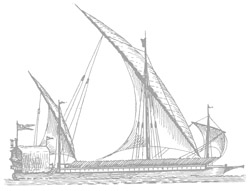

City of Fortune
City of Fortune
There are of course simply hundreds of books about Venice, but curiously few for the general reader that discuss its maritime empire or its commercial imperatives – the activities and locations which let the city exist. This silence in itself has furthered what historians have come to call the myth of Venice – the notion that the city was somehow a gravity-defying marvel, rising miraculously out of the haze of the lagoon and always destined for a unique greatness. This is how we all experience it for the first time. No matter how many gondola-and-Cornetto images precede that first visit, Venice never fails to strike us with utter astonishment, as something outside the norm. It always has done: the accounts of fifteenth century pilgrims are no different in tone.
What is missing from that first multicoloured glimpse – and seldom filled in later – is an understanding of its foundations. The mirage of Venice – the moonlight and the romance of the Grand Canal, the sense of being transported to another world – was the fruit of hundreds of years of sober effort. Venice was the most factual city in the world. It relied on trade, shipping, bills of exchange, severe accounting, colonial exploitation, sea warfare, collective self-discipline and ruthless single-mindedness. Its heroes were merchants and seamen, sombrely dressed, shrewd and hard-headed. For all the mythological rhetoric, Venice rested on profoundly material facts. It was a seafaring republic of wood, iron, rope, rudders and oars. It operated on economic principles and quickly grasped the laws of supply and demand, the importance of consumer choice and a stable currency, on-time delivery, the rule of law and rational taxes. It was startlingly modern.
I did not set out to explore the myth of Venice. I simply became fascinated by the Republic’s maritime adventure, which transformed a scattering of muddy islands into the richest city on earth. Its inhabitants seemed ubiquitous in the Mediterranean arena. They had cropped up tangentially in both my previous books, slipping ambivalently between the competing loyalties of rival faiths and empires. And they were everywhere: in the Adriatic, on the shores of Greece, on the great islands of Crete and Cyprus and in the furthest reaches of the Black Sea. Their city was a vivid reflection of Constantinople, which preoccupied them for a thousand years; their ambassadors sat down gravely in the airy and fragrant pavilions of the sultans of Cairo; their merchants carried back from the Levant oriental spices, words and visual motifs in the holds of their great galleys; their sea captains battled the Genoese for commercial monopoly and the Ottomans for empire. In the process Venice became for a while the axis of the world – all in the name of trade. It was too fascinating to resist.
